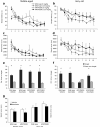Vitamin C reduces spatial learning deficits in middle-aged and very old APP/PSEN1 transgenic and wild-type mice
- PMID: 19539642
- PMCID: PMC2725435
- DOI: 10.1016/j.pbb.2009.06.006
Vitamin C reduces spatial learning deficits in middle-aged and very old APP/PSEN1 transgenic and wild-type mice
Abstract
Alzheimer's disease is a progressive and fatal neurodegenerative disease characterized by a build up of amyloid beta (Abeta) deposits, elevated oxidative stress, and deterioration of the cholinergic system. The present study investigated short-term cognitive-enhancing effects of acute intraperitoneal (i.p.) Vitamin C (ascorbate) treatment in APP/PSEN1 mice, a mouse model of Alzheimer's disease. Middle-aged (12 months) and very old (24 months) APP/PSEN1 bigenic and wild-type mice were treated with ascorbate (125 mg/kg i.p.) or the vehicle 1 h before testing on Y-maze spontaneous alternation and Morris water maze tasks. Very old mice performed more poorly on cognitive tasks than middle-aged mice. Ascorbate treatment improved Y-maze alternation rates and swim accuracy in the water maze in both wild-type and APP/PSEN1 mice. Abeta deposits and oxidative stress both increased with age, and acetylcholinesterase (AChE) activity was significantly reduced in APP/PSEN1 compared to wild-type mice. However, the short course of acute ascorbate treatment did not alter Alzheimer-like neuropathological features of plaque deposition, oxidative stress, or AChE activity. These data suggest that ascorbate may have noötropic functions when administered parenterally in high doses and that the mode of action is via an acute, pharmacological-like mechanism that likely modulates neurotransmitter function.
Figures




References
-
- Alzheimer's Association 2008 Alzheimer's disease facts and figures. Alzheimers Dement. 2008;4:110–33. - PubMed
-
- Arzi A, et al. Effect of vitamins C and E on cognitive function in mouse. Pharmacol Res. 2004;49:249–52. - PubMed
-
- Bernardo A, et al. Elimination of GD3 synthase improves memory and reduces amyloid-beta plaque load in transgenic mice. Neurobiol Aging. 2008 - PubMed
-
- Bernardo A, et al. Impaired spatial memory in APP-overexpressing mice on a homocysteinemiainducing diet. Neurobiol Aging. 2007;28:1195–205. - PubMed
Publication types
MeSH terms
Substances
Grants and funding
LinkOut - more resources
Full Text Sources
Medical
Molecular Biology Databases

